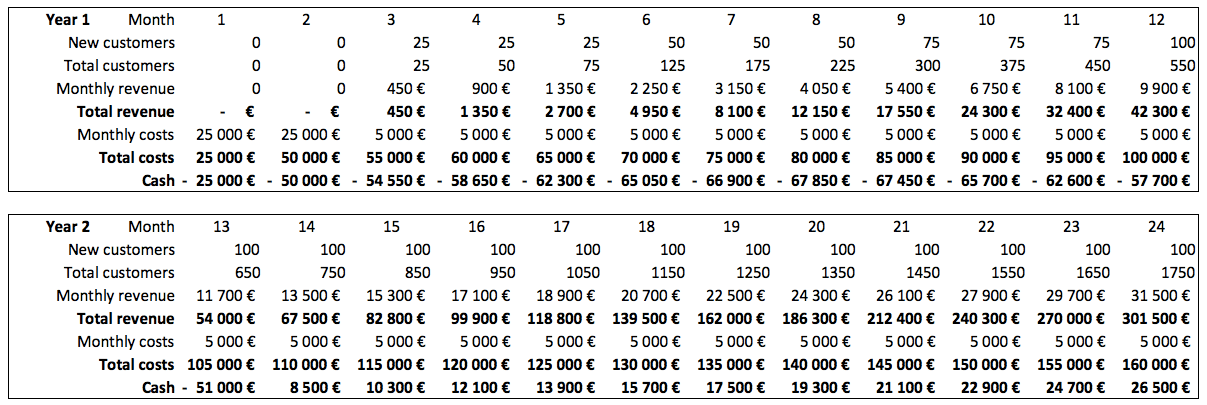If you are a digital product owner or in the C-suite at your company, you’re probably thinking about how technology expenditures will influence your bottom line. Developing custom software or licensing expensive digital solutions are complicated, yet oftentimes essential, investments to generate significant results in your organization. However, evaluating ROI can be complicated, making it much more challenging to explain their financial impact.
This article aims to provide you with a better knowledge of how to analyze the impact of your technology decisions on your company’s profit.
Why Need to Measure ROI for Custom Software Project?
Return on investment (ROI) is a key financial indicator for analyzing how your business optimizes outcomes and profits. In addition, ROI calculation is vital for determining how much money is invested in a specific team, project, hype campaign returns, etc.
Software development primarily aims to generate revenue that exceeds the costs of developing the software product or, at least, to cover the software investment while enhancing operations, decision-making skills, or competitive advantage. Therefore, the ROI measures how profitable or detrimental the project you’re working on is.
Learning how to calculate the ROI of custom software projects will help you:
- Know when and how you can justify further development of your software
- Determine ownership costs for your overtime revenue
- Recognize when you are at risk and whether you should make decisions in the best interest of your business based on market conditions.
- Gain a thorough picture of your project’s benefits and determines its profitability.
How will Software Types Determine the Ways You Measure ROI?
Methods for calculating ROI differ depending on the kind of software. In this part, we will concentrate on two main types of software: Business process software and SaaS.
1. Business Process Software
These bespoke software projects are intended to improve internal business processes and streamline your team’s workflow. To estimate the ROI for this kind of software, start by listing all areas where your business is able to generate revenue, lessen expenses, or enhance customer service with this software. As every company has unique workflows, the following software ROI calculation indicators can be used to have accurate measurement:
- Cost of software operations
- Opportunities for growing revenue by gaining more deals with the same amount of staff or by acquiring more clients.
- The degree of development and increase of your sales efficiency.
- Risks related to forecasting, avoiding, or managing problems sooner. The value that reduced risk or process standardization provides your company.
- The level of improved customer experience can generate new leads and retain current customers.
- The amount of saved time, energy, and resources.
Example: The net gain from developing an internal proposal software for a large engineering firm.

Once you understand the degree of investment to develop business process software and the chance to obtain tangibly from the investment, you can make the right decisions of whether or not to proceed.
2. Commercial Software or Saas
SaaS businesses (also known as software as a service) develop software to service certain users. As your company’s primary source of income. this type of software intends to grow your revenue.
A substantial consideration is a time that the SaaS company has been trading since enterprises in their infancy demand more expenditures to get the show off the ground. In these cases, the ROI will be measured via revenue generated by subscriptions to the software service in MRR or ARR subscription terms (monthly/annual recurring revenue). For instance, a technology business building advanced project management software might compare subscription income against the cost of software development, implementation, and client search.
How to calculate ROI for SaaS companies:
- Calculate your break-even point. Of your investment, how many users do you require to have, or How long does it take to break even between your revenue and expenses? Most SaaS businesses often struggle to reach the break-even point early since their software cannot attract many customers, and they’re still seeking the proper product-market fit.

- Consider the expenses as your company grows, such as software development costs, customer service and sales costs, marketing costs, office rent, administrative costs, etc. Some metrics of success for SaaS companies are cash flow, monthly customer churn rate, cost per acquisition, client LTV, etc.

- A good rule of thumb when developing a commercial softwrae is to figure out, “What is the minimum amount of features my product needs to make a sale?” More often than not, SaaS companies are found to overcomplicate their product by concentrating on far too many features while not digging deeply enough into one or two of them.
What is the ROI Formula for Custom Software Development?
1. Investment to Consider when Calculating the ROI
An ROI estimate is ultimately objective, and the parameters involved might vary based on the nature of the software development project. Businesses often have their own distinct processes and amount of investment. However, they may have the same considerations when deciding the costs involved with custom software development. Here are the key costs to identify when evaluating the ROI of a custom software project:
- Hardware Costs: Relevant expenditures must be incorporated if the new software needs any hardware updates
- Implementation Costs: Several reasons make software implementation costly, such as unstable requirements, wider target audience, increased project complexity, etc. Companies are required to consider data migration, hindered data operations, and a broad transition to the new system.
- Training Costs: New software typically comes with training costs. Without sufficient training, all potential profits from the new system will be lost.
- Support Costs: Ongoing software maintenance and support costs are typically approximately 20% of the initial development cost. This has an impact on yearly net income and must be included when calculating average ROI.
2. Sources of Business Profit when Calculating ROI
When developing the custom software, you’ll need to consider many areas that the investment in software can bring to the companies. Here is where your profits come from:
| Revenue Gains |
Competitive advantage | What is the value if you gain a competitive edge in your market? |
| Net new revenue | How much net new revenue could you generate with the same amount of staff by operating more efficiently? Will this create an entirely new line of revenue? | |
| Winning more customer accounts | Does this technology allow you to win new customers you previously couldn’t serve? Either through the software itself or by reallocating employee time and accountabilities from cost-center activities to revenue-generating activities? | |
| Winning consumer preference & evangelism | What would it mean for you to win consumer preference so much that people rave about their experience to other potential buyers? | |
| Increased customer lifetime value | What would it be worth to grow your customer’s lifetime value? | |
| Operational improvements | Increased understanding of customer needs | What would it be worth to have more & better customer data at your fingertips? |
| Standardize project workflow & deliverables | What would it be worth if you could standardize your projects, team workflow, and deliverables to clients? | |
| Delivering features on time and within budget | How could you meet or exceed customer expectations, all while streamlining your planning and operations? | |
| Opportunistic access & coordinated analysis | What would it be worth to understand data across all your customers and products that allowed you to create more intelligent apps? | |
| Intangible values |
Brand value & prestige |
What is the value of boosting your customers’ perception of your brand? |
| Minimize recurring issues | What if your teams’ overall quality improved? | |
| Confidence in strategy | What if you gained the confidence needed to move forward? |
3. ROI Formula
You can calculate ROI simply by subtracting the project’s actual or expected profits from its actual or estimated expenses. The outcome is the project’s total profit or expected profit. KMS Solutions proposes a simple formula for ROI as follows:
ROI = (Net Profit / Cost of Investment) x 100
Steps to activate this formula:
- Consider all expenditures related to the bespoke software development project when calculating the investment cost. These will comprise the costs mentioned above. Moreover, you also need to include annual operational expenses and any net income losses arising from software implementation.
- Determine the overall savings and profits a bespoke software project can obtain. This can be difficult to do, particularly initially. Most firms rely on estimation if there isn’t any concrete evidence available. Consider if the new software has led to increased productivity, less expensive errors, more sales, and other kinds of profit or savings.
Example: A tech company has invested 5 years in developing a custom software project. The software was released 4 years ago and has generated income from revenue, cost reductions, and more. The formula is as below:

How does Outsourcing Development Affect ROI?
Calculating the ROI of a custom project is essential for firms seeking to update or modernize their existing software. This means you’ll need to consider costs such as implementation, maintenance, training, and hardware in comparison with potentially profitable areas like increased efficiency, sales, and customer satisfaction. Outsourcing software development is one of the effective ways to help you relieve the stress concerning those expenses and just focus on the profits that the external digital team can bring to your business.
Moreover, it also enables dedicated software development teams like ours at KMS Solutions to undertake a bespoke software project with an entire concentration. Internal teams may be distracted by other tasks and operational challenges, stretching completion dates and increasing costs.
Consequently, outsourcing software development might result in a greater ROI due to a delicate and ultimately more skilled development process. In light of the fact that software development companies are at the forefront of technological growth, your product will be more dynamic and resilient. So, as an IT outsourcing partner, we can help you develop effective software and streamline architecture to take your business to the next level!










